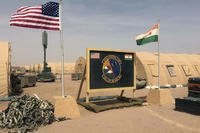Whatever happens to Libya's ex-strongman, Moammar Qaddafi, he and his regime are leaving behind a comprehensive arsenal of nasty weapons. And although world opinion has surged with the fortunes of Libya's rebel alliance this week, it wasn't very long ago that American officials were saying, well, we don't really know who many of these guys are. Some rebel fighters could be the same people who have attacked American troops in Iraq or elsewhere -- or at very least, they belong to the same clubs.
So a fractious, polyglot new government will take hold of what remains of Qaddafi's armed forces. There might not be much left, though -- the American and NATO campaign did a very thorough job obliterating Qaddafi's air and ground units, which never did belong to the edgiest military in the world. But there's also the matter of Qaddafi's thousands of rifles, rocket propelled grenade launchers, man-portable air defense systems, and who knows what other human-portable weapons he had stockpiled around the country. (Follow that link to see some of them.) What's to stop unscrupulous rebels from squirreling away whatever they find, or funneling it to potential terrorist compatriots out of the country?
One strategy is for the U.S. and its allies to try to be there at the arms bazaar when these weapons go on the block. As Flavia Krause-Jackson and John Walcott of Bloomberg report, American officials are particularly concerned about the surface-to-air missiles:
There is evidence that a small number of Soviet-made SA-7 anti-aircraft missiles from Qaddafi’s arsenal have reached the black market in Mali, where al-Qaeda in the Islamic Maghreb is active, according to two U.S. government officials not authorized to speak on the record. The disintegration of Qaddafi’s four-decade dictatorship has created a business opportunity for looters trafficking in the war-stricken country’s missiles, which would enable terrorists to attack military or civilian aircraft. With a buyback program, operatives on the ground seek out the sellers and offer high prices to recover the weapons.
They continue:
“We’re very concerned about those weapons turning up in neighboring countries,” Frederic Wehrey, a senior policy analyst at the RAND Corp. in Santa Monica, California, who’s been studying the Libyan uprising, said in a telephone interview. “They’re the ideal terrorist weapon -- portable, easy to use and capable of inflicting large numbers of casualties.”Army General Carter Ham, head of the U.S. military’s Africa Command, told the Senate Armed Services Committee on April 6 that Libya once had as many as 20,000 surface-to-air missiles. “Many of those, we know, are now not accounted for, and that’s going to be a concern for some period of time,” he said.
The Soviet SA-7 and SA-7b, an updated model, are the main shoulder-fired missile in Qaddafi’s arsenal. The units are about five feet long and sell on the black market for several thousand dollars, although the price fell as low as $500 when Saddam Hussein’s weapons were looted and flooded the market after the 2003 U.S. invasion of Iraq, according to a 2004 report from the Federation of American Scientists.
“This is a dangerous problem, clearly,” Lynn Pascoe, United Nations under-secretary-general for political affairs, told reporters today in New York. “When you have this many weapons around, one priority is to start seeing how you re- gather some of these weapons.”
One ace in the hole for the U.S. and NATO will be the high favor they still enjoy with much of the rebel leadership. There'll probably be a window of goodwill in which international operatives must act quickly to try to buy or destroy as many weapons as possible, before Libya's new government has a chance to change its mind.








